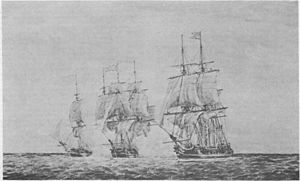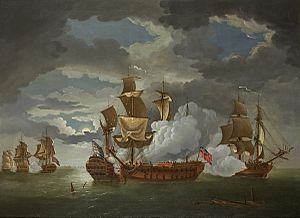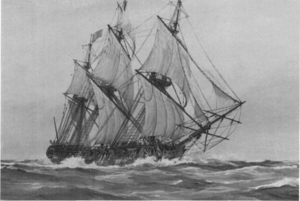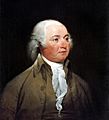Continental Navy facts for kids
Quick facts for kids Continental Navy |
|
|---|---|
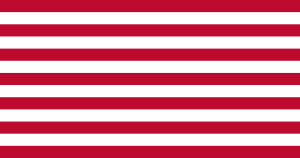
Continental Navy Jack
|
|
| Founded | 1775 |
| Country | |
| Allegiance | |
| Engagements | American Revolutionary War |
| Disbanded | 1785 |
| Commanders | |
| Chairman | John Adams |
| Commodore | Esek Hopkins |
| Notable commanders |
Captain John Paul Jones Captain John Barry |
The Continental Navy was the first official navy of the United States. It was created on October 13, 1775, during the American Revolutionary War. This navy helped the American colonies fight against Great Britain.
Its main job was to stop British ships carrying supplies and to interrupt their trade at sea. At first, the navy used regular merchant ships that were changed into warships. Later, new warships were built. Even though the Continental Navy didn't win many big battles, it showed America's determination. It also trained many officers who would later lead the early American navy.
After the war ended in 1783, the Continental Navy was closed down. The few remaining ships were sold because the new government needed money. The last ship was sold in 1785. The Continental Navy was the beginning of what is now the United States Navy.
Contents
The idea for a navy started because British soldiers had taken control of Boston. George Washington had already started using a few ships to stop British supplies. Other colonies also had their own warships.
The colony of Rhode Island was the first to officially ask for a Continental Navy. On August 26, 1775, Rhode Island's leaders asked Congress to build a strong fleet. This fleet would protect the colonies and attack their enemies. Many in Congress thought this was a crazy idea. Samuel Chase of Maryland called it "the maddest idea in the world." John Adams remembered that people thought it was "the most wild, visionary, mad project."
However, Congress learned that British supply ships were heading to Quebec. These ships carried important supplies that the American army desperately needed. So, Congress decided to act. They appointed Silas Deane and John Langdon to plan how to capture these ships.
On June 12, 1775, Rhode Island officially created its own navy. Captain Abraham Whipple was put in charge of their armed ships. Rhode Island's merchants had suffered a lot from British warships. This made them push for a single Continental fleet, paid for by the Continental Congress.
On October 3, 1775, Rhode Island's idea was brought to Congress, but it was put aside. Meanwhile, George Washington had already started getting ships. He chartered the schooner Hannah on September 5, 1775. This ship was the first to be used by Washington's forces.
On October 13, 1775, Congress made a big decision. They passed a resolution that officially created the Continental Navy. This date is now recognized as the birthday of the United States Navy. Congress agreed to buy two ships to attack British merchant ships. These ships became the Andrew Doria and the Cabot.
The first ship to be officially ready for duty was the USS Alfred. It was bought on November 4 and ready for service on December 3. On November 10, 1775, Congress also decided to create two battalions of Marines to serve with the fleet. John Adams wrote the first rules for the navy, which Congress approved on November 28, 1775. These rules were used for the entire Revolutionary War.
On December 13, 1775, Congress approved building 13 new warships called frigates. Five would have 32 guns, five would have 28 guns, and three would have 24 guns.
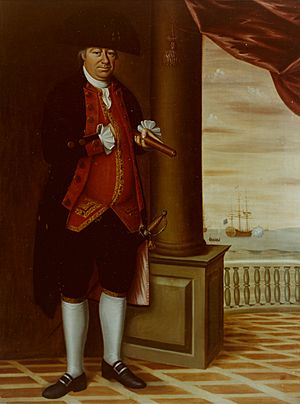
When it was time to choose commanders for the ships, Congress picked some based on their skills and others for political reasons. Esek Hopkins, Dudley Saltonstall, and John Burroughs Hopkins were chosen for political reasons. However, Abraham Whipple, Nicholas Biddle, and John Paul Jones were chosen because they had real experience in sea warfare.
On December 22, 1775, Esek Hopkins was made the commander-in-chief of the navy. Other officers were also given their positions. Saltonstall, Biddle, Hopkins, and Whipple became captains of the Alfred, Andrew Doria, Cabot, and Columbus.
Hopkins led the first major naval attack of the Continental Navy in March 1776. His small fleet included the Providence, Wasp, and Hornet. They attacked Nassau, Bahamas, and captured much-needed gunpowder for the Continental Army.
On April 6, 1776, Hopkins' fleet, with the addition of Fly, met the British ship HMS Glasgow. This was the first major sea battle for the Continental Navy. Hopkins failed to give clear orders, and the American ships scattered.
On Lake Champlain, Benedict Arnold ordered 12 warships to be built. These ships were meant to slow down the British fleet invading New York from Canada. Arnold's fleet was destroyed by the British. But the two-day Battle of Valcour Island did slow the British army's advance.
As the war continued, states began to put more effort into naval activities. Virginia bought land to build naval supplies. They even grew flax to make sail material because they didn't have money to buy linen cloth.
The Thirteen Frigates
By December 13, 1775, Congress had approved building 13 new frigates. These were proper warships, not just converted merchant ships. Five ships were to have 32 guns, five with 28 guns, and three with 24 guns.
Only eight of these frigates actually made it to sea. They were no match for the powerful British Royal Navy. Almost all of them were captured or sunk by 1781. Four frigates (Washington, Effingham, Congress, and Montgomery) were sunk or burned in 1777. This was done to stop the British from capturing them before they even sailed.
The USS Virginia tried many times to break through the British blockade of Chesapeake Bay. On March 31, 1778, it ran aground and was captured by British ships.
The main jobs of the Continental Navy were to protect American trade and attack British trade and supply ships. American privateers, which were private ships allowed to attack enemy vessels, were quite successful. Congress issued 1,697 "letters of marque," which were official permissions for privateers. It's estimated that American privateers captured 2,208 British ships. This caused a lot of financial damage to the British.
Most of the eight frigates that sailed captured several enemy ships before they themselves were captured. For example, the Delaware was captured in 1777 when it got stuck in the Delaware River. The Warren was trapped by the British in Providence, Rhode Island. It was later burned by its crew to prevent capture during the Penobscot Expedition in 1779.
The Hancock captured two merchant ships and a British warship, HMS Fox. But on July 8, 1777, the Hancock was captured by the British ship HMS Rainbow. It was then used by the British navy.
The Randolph captured five ships. On March 7, 1778, it was protecting American merchant ships when it met the much larger British ship HMS Yarmouth (64 guns). The Randolph fought bravely to protect the merchant ships. During the fight, the Randolph's gunpowder storage exploded, destroying the ship and killing almost everyone on board. The explosion also badly damaged the Yarmouth, stopping it from chasing the American merchant ships.
The Raleigh captured three ships before it ran aground during a battle in 1778. Its crew tried to sink it, but the British raised it and used it themselves.
The Boston captured 17 ships and even carried John Adams to France in 1778. It was captured along with the frigate Providence (which had captured 14 ships) when Charleston, South Carolina fell to the British in 1780.
The last frigate to serve the Continental Navy was the Trumbull. It fought bravely against the British ships HMS Iris and General Monk on August 28, 1781. The Trumbull was forced to surrender. Interestingly, the General Monk was actually a captured American privateer that the British were using.
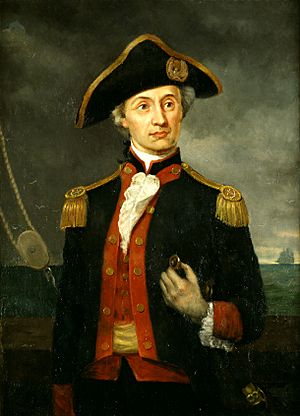
Before France officially became an ally, the French government tried to stay neutral during the war. However, they often helped American ships in their ports and supplied them. American diplomats like Benjamin Franklin and Silas Deane helped the Continental Navy connect with France. Through them, American officers could get permission to serve and buy ships for military use.
Early in the war, Captains Lambert Wickes and Gustavus Conyngham used French ports to attack British trade ships. France did try to stay neutral by seizing some American ships. But when the official alliance began in 1778, French ports were fully open to American ships.
The most famous American officer to operate from France was Captain John Paul Jones. He had been attacking British trade ships with the Ranger. Now, he saw a chance for a bigger command. The French loaned Jones a merchant ship called Duc de Duras. Jones refitted it and renamed it Bonhomme Richard.
In August 1779, Jones was given command of a group of American and French ships. Their goal was to attack British trade and possibly land French soldiers in Britain. The French later changed their mind about the invasion. But Jones still led his naval group. They sailed around Ireland and down the east coast of Britain, capturing many merchant ships.
On September 23, 1779, Jones's group met the British warships HMS Serapis and Countess of Scarborough. The Bonhomme Richard fought the Serapis. The two ships became tangled together. Many of Jones's guns were out of action. The British captain asked Jones if he was giving up. Jones famously replied, "I have not yet begun to fight!" Jones's crew then boarded the British ship and captured it. The French ship Pallas captured the Countess of Scarborough. Two days later, the Bonhomme Richard sank because of the heavy damage it had taken. This battle was a big embarrassment for the British Royal Navy.
France also loaned the Continental Navy the ship Ariel. The only large "ship of the line" built for the Continental Navy was the 74-gun America. But it was given as a gift to France in 1782. This was to make up for the loss of a French ship that helped the American Revolution.
France officially joined the war on June 17, 1778. French fleets helped American forces in different ways. In 1779, a French fleet helped try to recapture Savannah, Georgia. In 1780, a French fleet with 6,000 soldiers landed in Newport, Rhode Island.
In 1781, George Washington and French General Rochambeau planned an attack in the Chesapeake Bay area. This attack would happen when a large French fleet arrived. Washington and Rochambeau marched their armies to Virginia. On September 5, 1781, the French fleet fought the British in the Battle of the Virginia Capes. The French won, taking control of Chesapeake Bay. With the French fleet protecting them from the sea, American and French forces surrounded the British army at Yorktown, Virginia. They forced the British to surrender, which effectively won the war. Peace came two years later.
About 65 ships served in the Continental Navy during the war. Only 11 of them survived. The Treaty of Paris in 1783 officially ended the Revolutionary War. By 1785, Congress had decided to close down the Continental Navy. They sold the remaining ships.
The frigate Alliance fired the last shots of the war. It was also the very last ship in the navy. Some in Congress wanted to keep it, but the new country did not have enough money to keep it running. So, it was sold for $26,000. The navy was dissolved because of a lack of money, the loose way the states were connected, and a shift from war goals to peace goals.
See also
 In Spanish: Armada Continental para niños
In Spanish: Armada Continental para niños
Images for kids
-
John Adams helped create the navy and its rules. Painting by John Trumbull, c. 1792–93.


